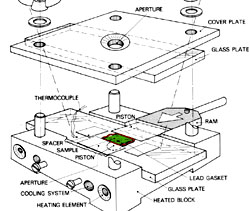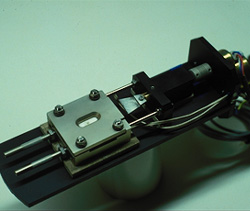Introduction
Building on pioneering work in the sixties, the experiments used thin (usually around 0.1 mm thick) samples of a transparent crystalline material sandwiched between two glass plates, to generate plane strain. A large variety of model materials were tried (e.g. Wilson, this volume, Hafner and Passchier, this volume, McLaren, this volume, Ree, this volume, Park, this volume, and the apparatus and the technique was slowly improved over the years. Improvements to the cell design were made to deform samples containing pore fluid and to allow very high shear strains in a ringshear arrangement (Jessell and Lister 1991).
A landmark paper was presented by Means (1983) who inserted inert markers into the sample to simultaneously observe the displacement path of many points in the sample and the miscrostructural evolution. Reviews of early work are presented in Urai et al., 1986, Means 1990 and Bons 1993. Modern work has explored the deformation of polyphase materials, combined the microstructural data with accurate measurement of mechanical properties in bulk samples, and developed further refinements to control the stress in the samples, together with the pore fluid pressure. Measurements were compared with finite element models of the experiment. Major advances were the development of analytical tools to analyse the displacement field with high resolution (Bons et al., 1993) and simultaneously the change in crystallographic orientation (Heilbronner, this volume).
Work is in progress to develop cells for use at high pressure and temperature deformation experiments. The latest paper using this technique is that of Bauer et al., (2000). It seems therefore that transmitted light deformation is now a well-established and useful tool in structural geology, with a potential for further contributions.
In a number of early studies cine cameras were used to prepare time lapse movies of the experiments. These movies were a useful basis for further analysis, and in addition to being excellent teaching tools. Videotapes based on this material have been in circulation over a decade, but with the advent of digital video it has become much easier to distribute such material.
This contribution presents a collection of digitized time-lapse movies of experiments with a variety of model materials. Most of these experiments have been carried out more than fifteen years ago, and were describe in detail in publications. The movies can serve as a useful resource base for these papers. In addition the movies are useful as teaching resource. Where appropriate, reference is made to the relevant publications, and therefore the descriptions are kept short.

